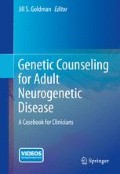Abstract
Dystonia is the third most common movement disorder. It is characterized by abnormal fixed positions and twisting movements. Dystonia can be sporadic or inherited. Classifications are made by age of onset, affected body part, whether it is primary, secondary or heredodegenerative, and by the presence or absence of other movement disorders. Numerous genes can cause dystonia, complicating testing and diagnosis. Inheritance patterns can be autosomal dominant, autosomal recessive, or X-linked. Incomplete penetrance, imprinting, pleiotropic genes, and heterogeneous conditions are all seen. These genetic phenomena can present difficulties for genetic counseling. The most common genetic dystonias are presented in this chapter.
Access this chapter
Tax calculation will be finalised at checkout
Purchases are for personal use only
References
Fuchs, T., & Ozelius, L. J. (2011). Genetics of dystonia. Seminars in Neurology, 31(5), 441–448.
Fuchs, T., Saunders-Pullman, R., Masuho, I., Luciano, M. S., Raymond, D., Factor, S., et al. (2013). Mutations in GNAL cause primary torsion dystonia. Nature Genetics, 45(1), 88–92.
Bressman, S. B., Sabatti, C., Raymond, D., de Leon, D., Klein, C., Kramer, P. L., et al. (2000). The DYT1 phenotype and guidelines for diagnostic testing. Neurology, 54(9), 1746–1752.
Markun, L. C., Starr, P. A., Air, E. L., Marks, W. J., Jr., Volz, M. M., & Ostrem, J. L. (2012). Shorter disease duration correlates with improved long-term deep brain stimulation outcomes in young-onset DYT1 dystonia. Neurosurgery, 71(2), 325–330.
Panov, F., Gologorsky, Y., Connors, G., Tagliati, M., Miravite, J., & Alterman, R. L. (2013). Deep brain stimulation in DYT1 dystonia: A 10-year experience. Neurosurgery, 73(1), 86–93. discussion 93.
Risch, N. J., Bressman, S. B., Senthil, G., & Ozelius, L. J. (2007). Intragenic cis and trans modification of genetic susceptibility in DYT1 torsion dystonia. The American Journal of Human Genetics, 80(6), 1188–1193.
Lee, L. V., Munoz, E. L., Tan, K. T., & Reyes, M. T. (2001). Sex linked recessive dystonia parkinsonism of Panay, Philippines (XDP). Molecular Pathology, 54(6), 362–368.
Evidente, V. G., Advincula, J., Esteban, R., Pasco, P., Alfon, J. A., Natividad, F. F., et al. (2002). Phenomenology of “Lubag” or X-linked dystonia-parkinsonism. Movement Disorders, 17(6), 1271–1279.
Brashear, A., Dobyns, W. B., de Carvalho Aguiar, P., Borg, M., Frijns, C. J., Gollamudi, S., et al. (2007). The phenotypic spectrum of rapid-onset dystonia-parkinsonism (RDP) and mutations in the ATP1A3 gene. Brain, 130(Pt 3), 828–835.
Raymond, D., Saunders-Pullman, R., de Carvalho, A. P., Schule, B., Kock, N., Friedman, J., et al. (2008). Phenotypic spectrum and sex effects in eleven myoclonus-dystonia families with epsilon-sarcoglycan mutations. Movement Disorders, 23(4), 588–592.
Camargos, S., Lees, A. J., Singleton, A., & Cardoso, F. (2012). DYT16: The original cases. Journal of Neurology, Neurosurgery & Psychiatry, 83(10), 1012–1014.
Nolte, D., Niemann, S., & Muller, U. (2003). Specific sequence changes in multiple transcript system DYT3 are associated with X-linked dystonia parkinsonism. Proceedings of the National Academy of Sciences of the United States of America, 100(18), 10347–10352.
Makino, S., Kaji, R., Ando, S., Tomizawa, M., Yasuno, K., Goto, S., et al. (2007). Reduced neuron-specific expression of the TAF1 gene is associated with X-linked dystonia-parkinsonism. The American Journal of Human Genetics, 80(3), 393–406.
Furukawa, Y. (2013). GTP Cyclohydrolase 1-deficient dopa-responsive dystonia [online]. Retrieved December 6, 2013, from http://www.ncbi.nlm.nih.gov/books/NBK1508/
Muller, B., Hedrich, K., Kock, N., Dragasevic, N., Svetel, M., Garrels, J., et al. (2002). Evidence that paternal expression of the epsilon-sarcoglycan gene accounts for reduced penetrance in myoclonus-dystonia. The American Journal of Human Genetics, 71(6), 1303–1311.
Grabowski, M., Zimprich, A., Lorenz-Depiereux, B., Kalscheuer, V., Asmus, F., Gasser, T., et al. (2003). The epsilon-sarcoglycan gene (SGCE), mutated in myoclonus-dystonia syndrome, is maternally imprinted. European Journal of Human Genetics, 11(2), 138–144.
Foncke, E. M., Gerrits, M. C., van Ruissen, F., Baas, F., Hedrich, K., Tijssen, C. C., et al. (2006). Distal myoclonus and late onset in a large Dutch family with myoclonus-dystonia. Neurology, 67(9), 1677–1680.
Caviness, J. N., & Brown, P. (2004). Myoclonus: Current concepts and recent advances. Lancet Neurology, 3(10), 598–607.
Valente, E. M., Edwards, M. J., Mir, P., DiGiorgio, A., Salvi, S., Davis, M., et al. (2005). The epsilon-sarcoglycan gene in myoclonic syndromes. Neurology, 64(4), 737–739.
Lyon, G., Kolodny, E. H., & Pastores, G. M. (2006). Neurology of hereditary metabolic diseases of children. New York, NY: McGraw-Hill.
Schneider, S. A., & Bhatia, K. P. (2010). Rare causes of dystonia parkinsonism. Current Neurology and Neuroscience Reports, 10(6), 431–439.
Phukan, J., Albanese, A., Gasser, T., & Warner, T. (2011). Primary dystonia and dystonia-plus syndromes: Clinical characteristics, diagnosis, and pathogenesis. Lancet Neurology, 10(12), 1074–1085.
Bhatia, K. P. (2011). Paroxysmal dyskinesias. Movement Disorders, 26(6), 1157–1165.
Gardiner, A. R., Bhatia, K. P., Stamelou, M., Dale, R. C., Kurian, M. A., Schneider, S. A., et al. (2012). PRRT2 gene mutations: from paroxysmal dyskinesia to episodic ataxia and hemiplegic migraine. Neurology, 79(21), 2115–2121.
Lee, H. Y., Xu, Y., Huang, Y., Ahn, A. H., Auburger, G. W., Pandolfo, M., et al. (2004). The gene for paroxysmal non-kinesigenic dyskinesia encodes an enzyme in a stress response pathway. Human Molecular Genetics, 13(24), 3161–3170.
Suls, A., Dedeken, P., Goffin, K., Van Esch, H., Dupont, P., Cassiman, D., et al. (2007). Paroxysmal exercise-induced dyskinesia and epilepsy is due to mutations in SLC2A1, encoding the glucose transporter GLUT1. Brain, 131(Pt. 7), 1831–1844.
Author information
Authors and Affiliations
Corresponding author
Editor information
Editors and Affiliations
1 Electronic Supplementary Materials
Below is the link to the electronic supplementary material.
Myoclonus dystonia Part 1 (MOV 254249 kb)
306795_1_En_4_MOESM2_ESM.mov
Myoclonus dystonia Part 2 (MOV 355128 kb)
Rights and permissions
Copyright information
© 2015 Springer Science+Business Media New York
About this chapter
Cite this chapter
Waugh, J.L., Multhapt-Buell, T. (2015). Dystonia. In: Goldman, J. (eds) Genetic Counseling for Adult Neurogenetic Disease. Springer, Boston, MA. https://doi.org/10.1007/978-1-4899-7482-2_4
Download citation
DOI: https://doi.org/10.1007/978-1-4899-7482-2_4
Published:
Publisher Name: Springer, Boston, MA
Print ISBN: 978-1-4899-7481-5
Online ISBN: 978-1-4899-7482-2
eBook Packages: Behavioral ScienceBehavioral Science and Psychology (R0)

